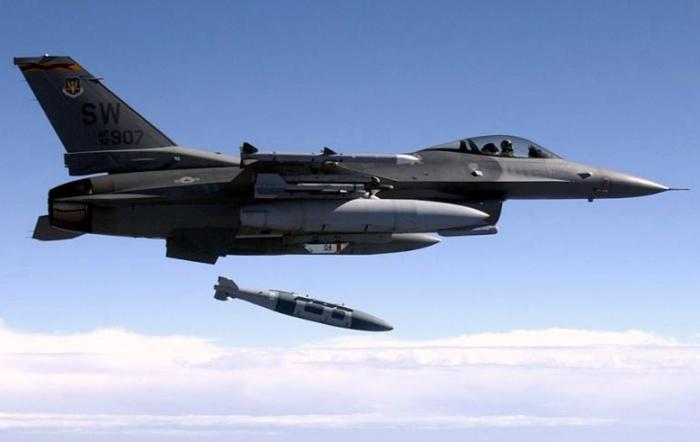
The National Nuclear Security Administration (NNSA) is still determining if problems with non-nuclear components will prevent the B61-12 gravity bomb and W88 Alt 370 submarine-launched ballistic missile warhead from entering service with the Air Force and Navy on time, according to an annual agency report released Wednesday.
The details are included in the agency’s 2020 Stockpile Stewardship and Management Plan: an annual document that is hundreds of pages long and provides Congress and the public with updates on the unclassified cost and schedule details of the NNSA’s weapons programs.
In the report, the NNSA said it needs to do “further testing” to determine whether a decision to not to use certain commercial-off-the-shelf capacitors in the B61-12 and W88 Alt 370 would delay the date by which the weapons could meet the military’s “Initial Operational Capability.”
Capacitors store electrical charges and can be used in detonation systems. In May, the NNSA said it would take months to figure out what to do about the unsuitable components.
When it disclosed in May that the capacitors did not meet military requirements, the NNSA did not say exactly what the problem was with the components — only that the setback would “probably” delay the dates by which the agency could produce the first war-ready B61-12 and W88 Alt 370.
Now, the agency has given notice that the delay might the Air Force and Navy to rely on older weapons for a little while longer.
The B61-12’s first production unit was due in 2020, the first W88 Alt 370 in 2019. Both programs were slated to end in fiscal 2025, but those schedules are now under “revision,” according to the 2020 Stockpile Stewardship and Management Plan.
The No. 2 officer at U.S. Strategic Command, which is in charge of the interservice U.S. nuclear arsenal, told reporters Wednesday the existing gravity bombs and submarine-launched warheads could “get the job done” in the event of a delay.
“The NNSA is top rate,” Navy Vice Adm. David Kriete said via teleconference from the Strategic Command Deterrence Symposium in Omaha, Neb. “They’re working really hard. They’re making progress and we’re in constant communications.”
The NNSA plans to build some 480 B61-12 bombs and has roughly 350 W88 warheads, the nongovernmental Federation of American Scientists estimates.
The W80-4 Crush
The 2020 Stockpile Stewardship and Management Plan is the first to include details on the updated cost and schedule estimate created since October 2018 by the program office in charge of the W80-4 life extension program: a planned decade-plus, $11-billion refurbishment intended to ready the W80 warhead to tip the Pentagon’s planned Long-Range Standoff Weapon air-launched nuclear cruise missile.
The Lawrence Livermore National Laboratory in California leads the W80-4 life-extension program, which hit phase 6.3 of its development in February: the point in NNSA project management where the agency produces the official cost-and schedule-baseline for nuclear weapons programs.
The agency is building warheads for the roughly 1,000 missiles the Pentagon plans to buy.
The W80-4 program office’s latest W80-4 cost estimate is not dramatically higher than estimates found in the last couple Stockpile Stewardship and Management Plans. However, the life-extension program’s near-term budget needs, beginning in 2020, are much higher than earlier estimates.
According to the new Stockpile Stewardship and Management Plan, previous estimates assumed less cost growth than did the latest estimate. In addition, the W80-4 program office is crushing to meet a promise to produce the first war-ready warhead by fiscal 2025. To hit the deadline, the office decided it had to cram more work into the early years of the program.
That resulted in the NNSA requesting nearly $900 million in funding for the program in the fiscal year that starts Oct. 1: $185 million more than what the agency thought, as recently as a year ago, it would need for 2020.
The agency’s nominally independent Cost Estimating and Program Evaluation (CEPE) office, in an eight-page memo dated January 2019, found it “highly unlikely” that the NNSA would manufacture the first W80-4 in fiscal 2025. A fiscal 2026 first production unit is “more likely,” the memo says.
A 2026 first manufacture would still allow the NNSA to deliver the first of the warheads in time to meet the Air Force’s goal of developing a war-ready Long-Range Standoff Weapon by 2030, the CEPE memo says.
CEPE said the NNSA is overly optimistic about how long it will take to manufacture certain non-nuclear W80-4 components, given that it took the agency years longer to churn out similar parts for the B61-12 nuclear gravity bomb that is now nearing the end of a planned 20-year life extension.
According to CEPE, the NNSA thinks it will take about six years to finish the W80-4’s firing set assembly and warhead control unit, which is respectively two years and one year less than it took the agency’s Honeywell-managed Kansas City National Security Complex to finish similar components for the B61-12.
Meeting the accelerated schedule for W80-4 would require “a rate of program execution that has not historically been demonstrated by the complex and is therefore highly unlikely,” the CEPE office said in the memo, a copy of which the NNSA provided to Nuclear Security & Deterrence Monitor. The non-nuclear components described in the report are different from the balky commercial-off-the-shelf components that have delayed B61-12’s first production unit beyond the NNSA’s scheduled fiscal 2020 date.